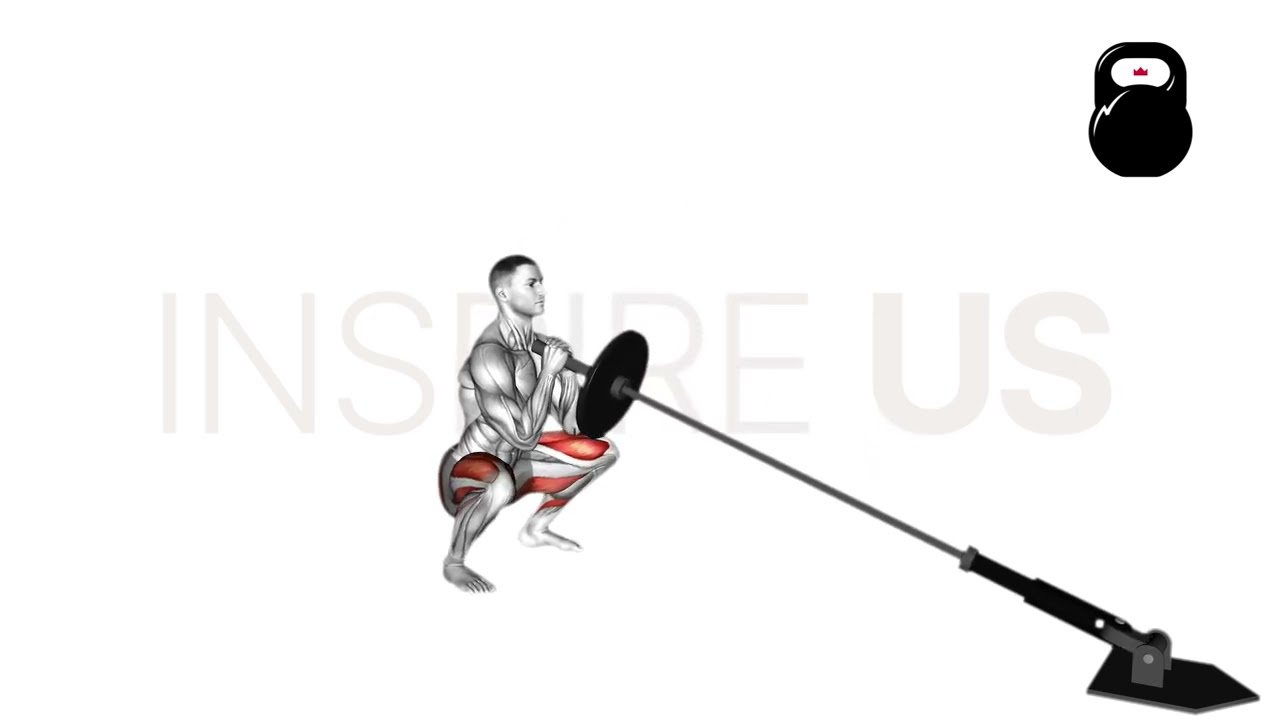Landmine Squats: Benefits, Muscles Worked, and More
Often performed as a supercharged form of goblet squat; the landmine squat is a veritable inclusion into any serious lower body workout.
As you can likely guess from its name, the landmine squat is simply a front-loaded squat performed with the use of a landmine attachment at one end of a barbell. This emphasizes the quads and greatly enhances the safety of the overall movement.
But before throwing the landmine squat into your leg day session, ensure that you have a full understanding of how to perform it correctly, what sort of benefits are offered and what mistakes you’ll need to avoid. All of these (and more) will be covered in this article.
What is a Landmine Squat?
The landmine squat is a compound lower body exercise primarily featuring hip and knee flexion while in a wide squatting stance.
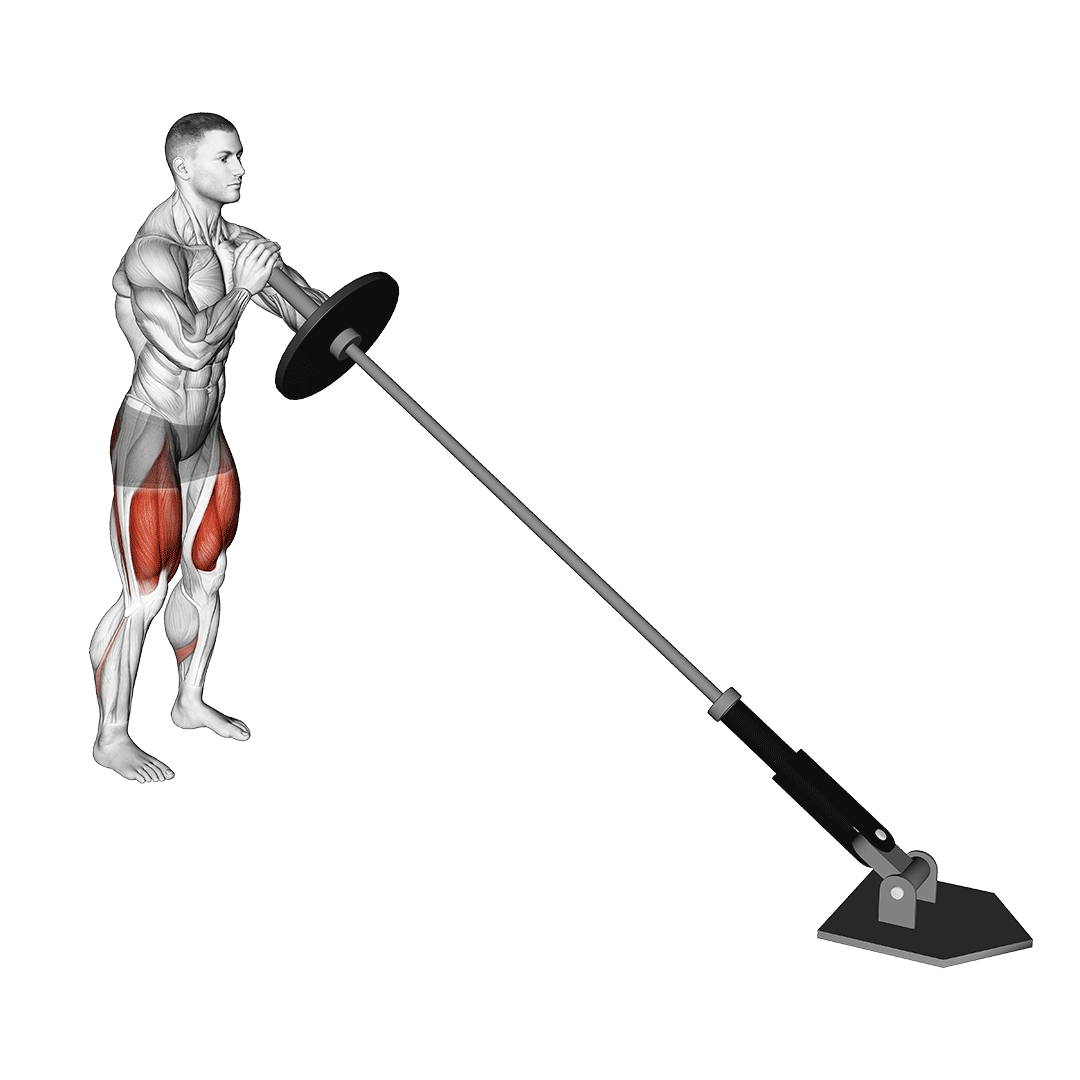
Unlike the classic back squat, landmine squats are an anterior-loaded movement, meaning that the load is placed at the front of the body. Most often, this is achieved by gripping one end of a loaded barbell in both hands at around chest height.
Landmine squats are practiced as a primary compound movement meant to emphasize the quadriceps, or as a form of sports-specific strength training for Olympic weightlifters, Strongman competitors and similar types of athletes.
Is the Landmine Squat the Right Exercise for You?
The landmine squat is more appropriate for lifters of at least an intermediate level of experience, as it requires a firm understanding of squatting mechanics and spine neutrality.
Likewise, it is most effective as a training tool for lifters who find their quadriceps to be underdeveloped or for athletes whose sport involves a movement pattern similar to that of the landmine squat itself. Hoisting an atlas stone or cleaning a bar are just a few examples of this.
How to Do a Landmine Squat
To perform a repetition of the landmine squat, the lifter will first insert one end of a barbell into a landmine apparatus with the opposite end loaded with a moderate amount of weight.
The lifter will then pick up the loaded end in both hands and hold it close to the body at chest height, their feet set shoulder-width apart with the toes pointing forwards and the head facing ahead. The core should be braced with the spine in a neutral curvature and the shoulders squared.
Now in the correct stance, the lifter will push their pelvis back and bend at the knees simultaneously - lowering themselves until reaching their desired squat depth. A good starting point is to align the hips with the top of the knees.
In order to avoid the elbows limiting the range of motion, it is best for the lifter to tuck their elbows to the sides of their ribs as they descend. The legs should be far enough apart for the elbows to fit between them.
Once reaching the desired depth, the lifter pushes the floor away through their heels and rises back into a standing position, the loaded end of the barbell still held at the same level as their chest.
When in a standing position once more, the repetition is considered complete.
What Muscles Does the Landmine Squat Work?
The landmine squat is what is known as a “compound” movement, meaning more than a single joint is involved in its movement pattern.
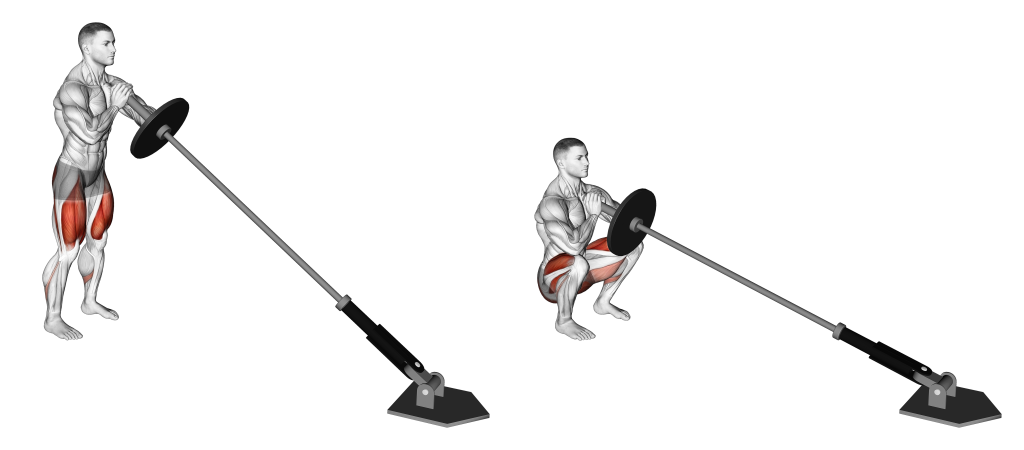
The muscles used to move these joints are classified according to the manner in which they work, with visible shortening or lengthening marking a muscle as a “mover”, and in-place contraction a “stabilizer”.
Primary and Secondary Mover Muscles
The landmine squat emphasizes the quadriceps femoris above all other muscle groups - however, that doesn’t mean that the hamstrings and glutes aren’t recruited to a similar capacity as well.
Stabilizer Muscles
In comparison to many other variations of squat, the landmine squat is unique in the fact that it uses the deltoids, chest and forearms as stabilizer muscles to hold the barbell in place. Of course, this will depend on how the bar is held and to what elevation.
Upper body muscles aside - the erector spinae, abdominals, obliques and other core muscles are also used as stabilizers alongside.
What are the Benefits of Doing Landmine Squats?
Apart from being generally good for your health, landmine squats also offer the following advantages.
Excellent for Building Lower Body Strength and Mass
Like most other types of squat, the landmine squat excels as a method of building muscle mass and strength throughout the lower body. This is especially the case for the quadriceps femoris, of which receive the most benefit from landmine squats due to the position of the load at the front of the body.
To get the best results from landmine squats, remember to align your training programming with your goals. Less volume and greater weight may be a more suitable choice if you are an athlete or wish to better condition yourself towards heavy squats.
Less Strain on Spine and Lower Back
Exercises like the back squat place the weight atop the - well, back. This causes vertical pressure to be created as the barbell presses downwards atop the spine, increasing the risk of injury and generally being less comfortable as far as the tissues of the back go.
In comparison, the landmine squat not only keeps the load away from the back, but also does not distribute said load directly into the body. Instead, the barbell is held in both hands, allowing the weight to better distribute across the upper torso and reducing any risk of injury occurring as a result.
Reinforces Correct Torso Orientation
For lifters who have trouble keeping their torso at the correct angle while lifting, the landmine squat can be an excellent way of correcting such an issue.
With the load kept at the front of the torso as it is held in the hands, the lifter will have to consciously work to keep their chest and shoulders positioned correctly. This carries over even into seemingly unrelated exercises like the deadlift or overhead press, where orientation of the torso can be pivotal in proper safety and performance.
Wider Stance, Less Mobility Requirements, and Shorter Range of Motion
Although a wider stance is not necessarily a benefit, it does indeed shorten the range of motion of each repetition - as well as reduce how much ankle, hip and knee mobility is needed to complete said repetition.
For lifters with mobility issues affecting their squat depth, the landmine squat can help act as a substitute to deeper squat variations.
Furthermore, a shorter range of motion means that less energy is expended over the course of a single repetition. This can allow for greater amounts of weight to be moved, if needed.
Carryover to Many Athletic and Real World Activities
The landmine squat is a highly functional exercise that features a similar movement pattern to many real world activities, be it hoisting groceries up to a counter or lifting an atlas stone in a Strongman competition.
In order to truly create a carryover effect with the landmine squat, the volume and weight programmed should be similar to the demands of your intended activity. For example, if you are a strength athlete, aim for lesser volume and greater weight at a slow tempo.
Strengthens Other Anterior Loaded Squat Exercises
Apart from carrying over to activities outside of the gym, performing landmine squats can also help improve performance of similar squat variations.
Movements like the goblet squat, front squat or Zercher squat all target the same muscles as the landmine variant in a similar recruitment pattern. Going off the law of specificity, improvement in one of these exercises will lead to partial improvements in all other similar exercises.
If you’ve reached a sticking point or plateau in your front squat progression, try switching to the landmine squat for a few sessions to see if the issues can be overcome.
Common Landmine Squat Mistakes to Avoid
Although the landmine squat is quite low-impact on the joints, it is important to avoid the following mistakes so as to prevent any injuries.
Stance Too Narrow
One of the more common errors seen with setting up the landmine squat is setting the legs too close together. A narrow stance can prematurely terminate the exercise’s range of motion as the elbows are stopped by the knees.
While the usual advice is to set the feet shoulder-width apart, this is only a suggestion. Lifters should experiment to find their ideal stance width that allows for a full range of motion to be achieved without risking hip issues.
Insufficient Range of Motion
As is the case with practically all other exercises, performing landmine squats with an incomplete range of motion will only reduce its benefits.
Depending on which half of the ROM is shortened, the quadriceps or glutes may be targeted to a lesser degree - leading to poor development and potential muscular imbalances over the long run.
A full landmine squat repetition should involve the lifter extending their legs into a standing position at the start and end of the movement. Furthermore, a full depth where the thighs are parallel to the floor is also ideal.
Leaning Into the Bar
Lifters with weak or fatigued core musculature may find themselves leaning forwards into the bar as they perform the landmine squat. This is a mistake, and will not only lead to a breakdown in stance but also potentially lead to a loss of balance.
Rather than using the bar for balance, the bar itself should be balanced in the lifter’s hands. The body’s weight should remain evenly distributed throughout the soles of the feet, with the torso only slightly leaned forwards to accommodate the bar.
Curving the Upper Back
In order to protect the spine and shoulders while performing landmine squats, the upper back should remain upright and in a neutral curvature. Curving the upper back forwards or hunching the shoulders can lead to strain along the cervical section of the spine and strain of the upper back’s musculature.
To do so, keep the shoulders aligned with the sides of the torso and ensure the chest is pushed out and upwards as the repetition is performed.
Other cues that may be beneficial are; keep the head facing forwards, the palms facing each other as they grip the bar and the scapula depressed throughout the exercise.
Knees Tracking Too Far Over Toes
Although how far your knees should track over your toes will depend on mobility and proportions, it is generally good practice to minimize this as much as possible.
The pelvis should be pushed back as full depth is reached during a squat, meaning that the body’s weight should not be distributed forwards but rather “sat back”, so to speak.
Allowing the knees to track too far forwards will increase pressure on the knee joint itself, as well as potentially compromise the entire stance as the pelvis ends at a higher point.
Frequently making this mistake despite adequate hip flexion could be a sign that your stance is too narrow or that your hips are excessively tight.
Alternatives to the Landmine Squat
If you don’t have access to a landmine apparatus or simply want to try a similar leg exercise, try these three alternatives out.
Goblet Squats
Goblet squats are almost mechanically identical to the landmine squat, only with the use of a kettlebell or a dumbbell, rather than a barbell and landmine apparatus. This allows for a somewhat closer position of the arms and less forward tilt to the torso.
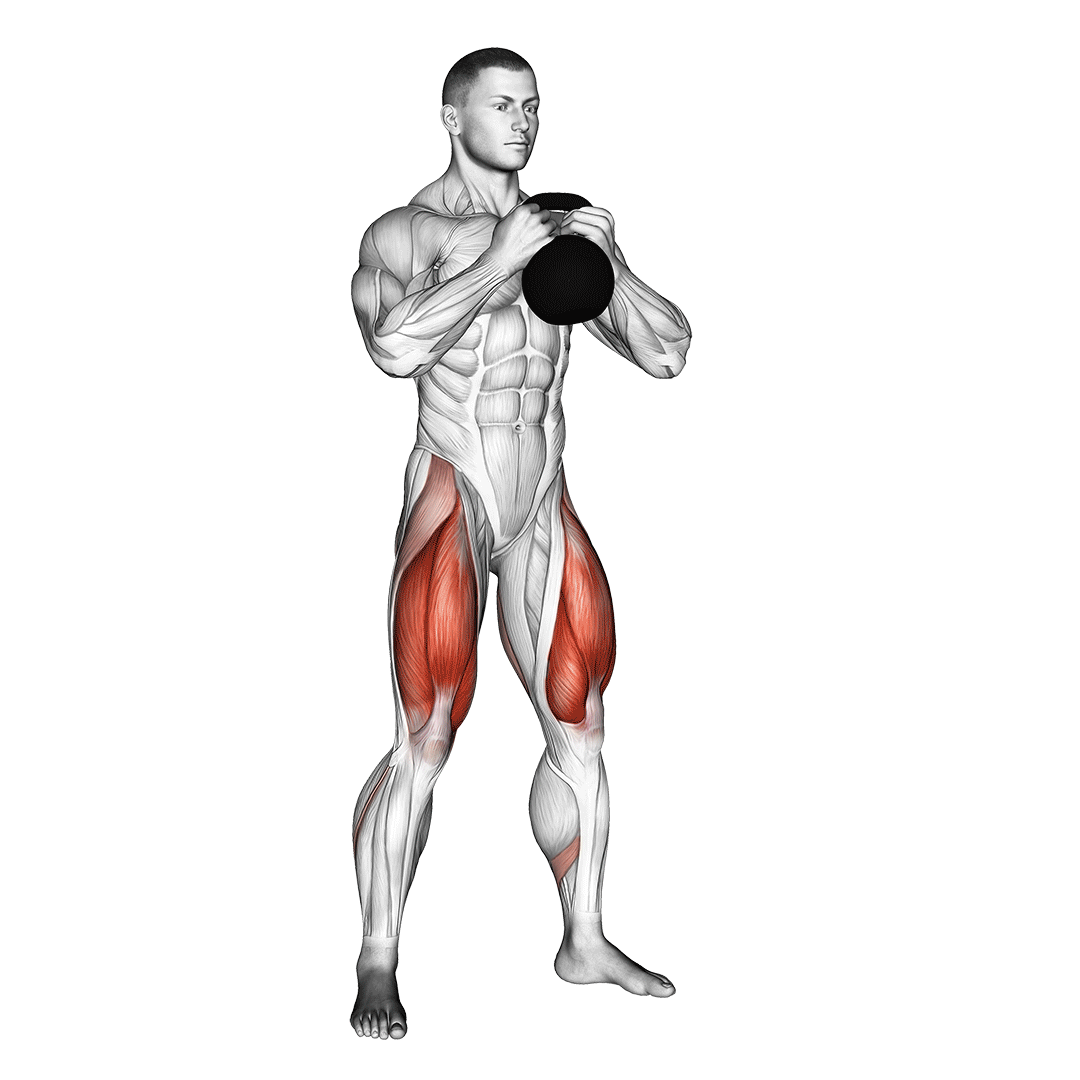
Goblet squats are the ideal alternative if no equipment to perform a landmine squat is available, or if you wish to avoid angling the body forwards as much as possible.
Overhead Landmine Reverse Lunges
The overhead landmine lunge is a technically complex variation of overhead lunge where the end of the barbell is held in one arm as a reverse lunge is performed.
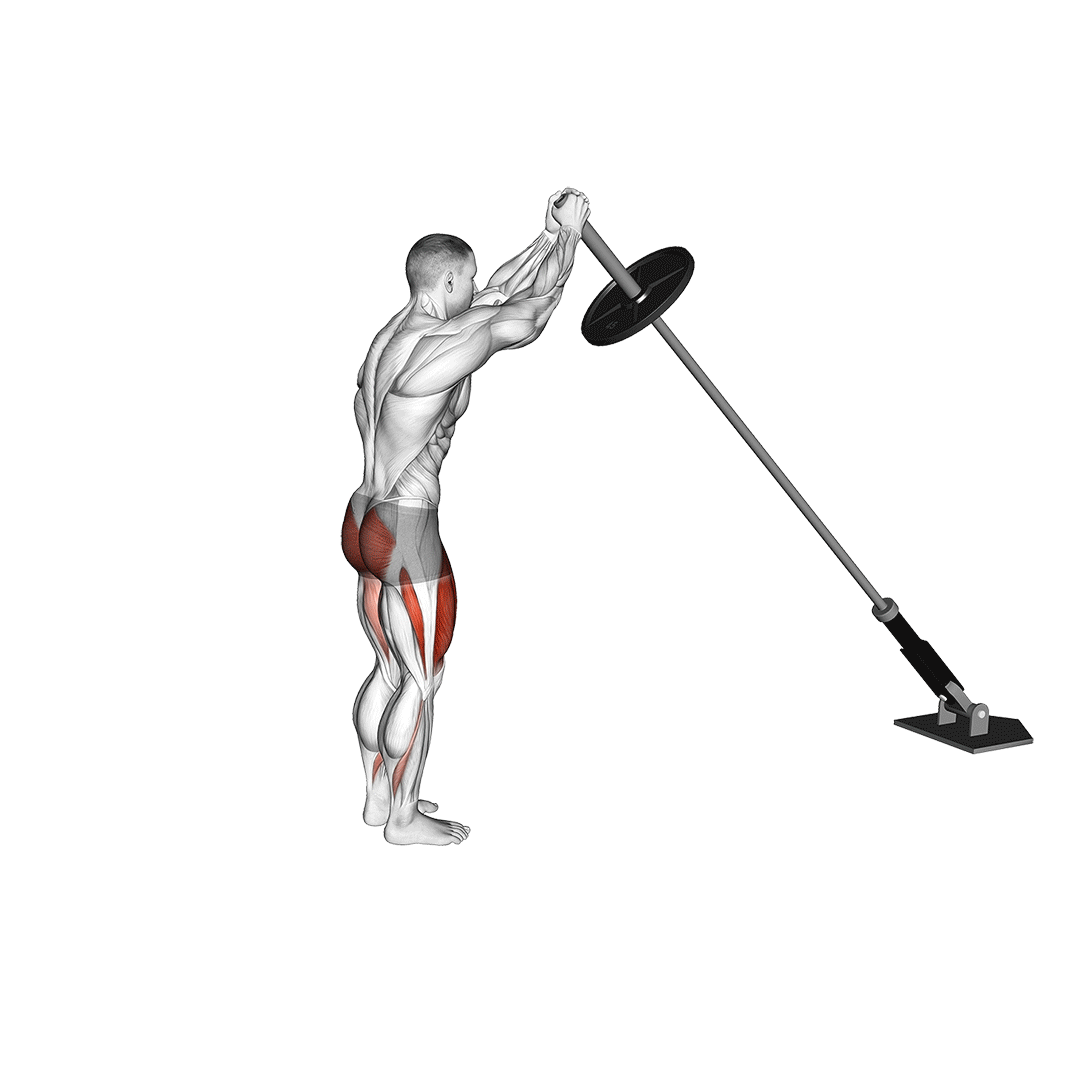
This creates greater engagement of the posterior chain and greatly reduces strain on the knees - even in comparison to landmine squats.
For athletes or those seeking an even more functional substitute to the landmine squat, the overhead landmine reverse lunge is ideal.
Overhead Landmine Squats
Overhead landmine squats are simply conventional landmine squats performed with the bar held even higher than chest height. This creates a greater emphasis on the triceps and deltoids - and allows for the lifter’s balance to be honed as well.
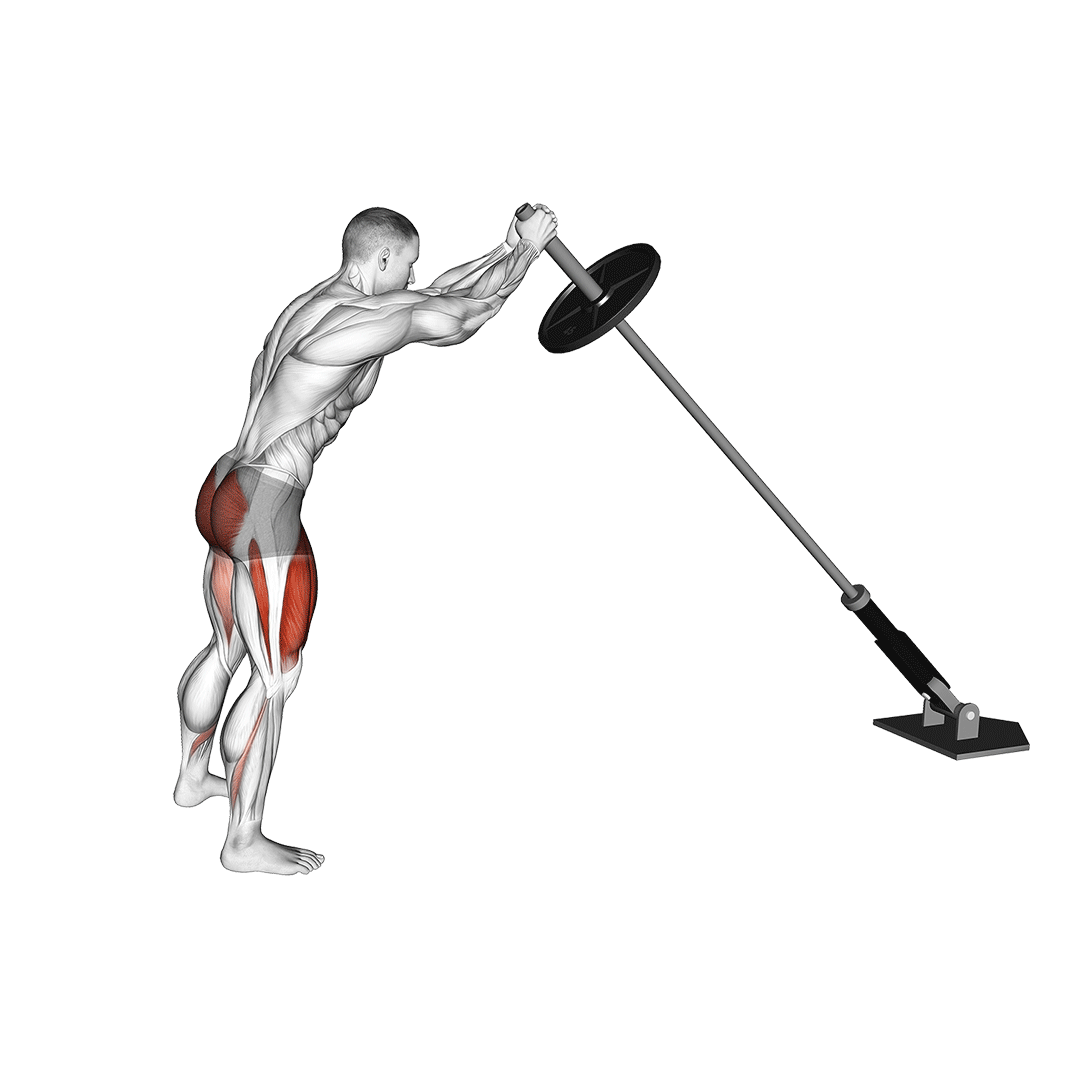
The overhead landmine squat is most often performed as a graduation from the landmine squat in athletic training programs - although it can also be used as a method of targeting both halves of the body simultaneously.
Frequently Asked Questions (FAQ)
What are Landmine Squats Good for?
Landmine squats are great for targeting the lower body without straining the spine and back. Because they don’t load the weight atop the shoulders, less vertical pressure is present - creating an overall more comfortable exercise.
Are Landmine Squats Better Than Regular Squats?
In certain respects - yes. The landmine squat is ideal for emphasizing the quadriceps, protecting your back and creating a more functional workout plan.
What is the Difference Between a Landmine Squat and a Goblet Squat?
The difference between a landmine and goblet squat is in its name. The former uses a barbell and landmine apparatus, whereas the latter uses any weighted object that can be held in a goblet style - usually a dumbbell or kettlebell.
However, there are also further differences between the two, such as the angle of resistance and the movement of the weight itself. These are largely minute and technical in nature, and the two exercises can be interchanged as needed.
In Summary
The landmine squat is an overall solid lower body exercise that reinforces proper torso orientation, features a low risk of injury and is excellent for building real-world physical strength.
When performed in tandem with exercises that focus on the posterior chain, lifters can build a truly powerful lower body in a short span of time.
Of course, remember to perform the landmine squat with form placed at the highest level of priority. Even if it is far safer than other squat variations, proper form will ensure that a proper training stimulus is achieved.
References
1. Illmeier G, Rechberger JS. The Limitations of Anterior Knee Displacement during Different Barbell Squat Techniques: A Comprehensive Review. J Clin Med. 2023 Apr 19;12(8):2955. doi: 10.3390/jcm12082955. PMID: 37109294; PMCID: PMC10143703.
2. Collins, Kyle S et al. “Differences in Muscle Activity and Kinetics Between the Goblet Squat and Landmine Squat in Men and Women.” Journal of strength and conditioning research vol. 35,10 (2021): 2661-2668. doi:10.1519/JSC.0000000000004094
3. Slater, Lindsay & Hart, Joe. (2016). Muscle Activation Patterns During Different Squat Techniques. Journal of Strength and Conditioning Research. 31. 1. 10.1519/JSC.0000000000001323.

